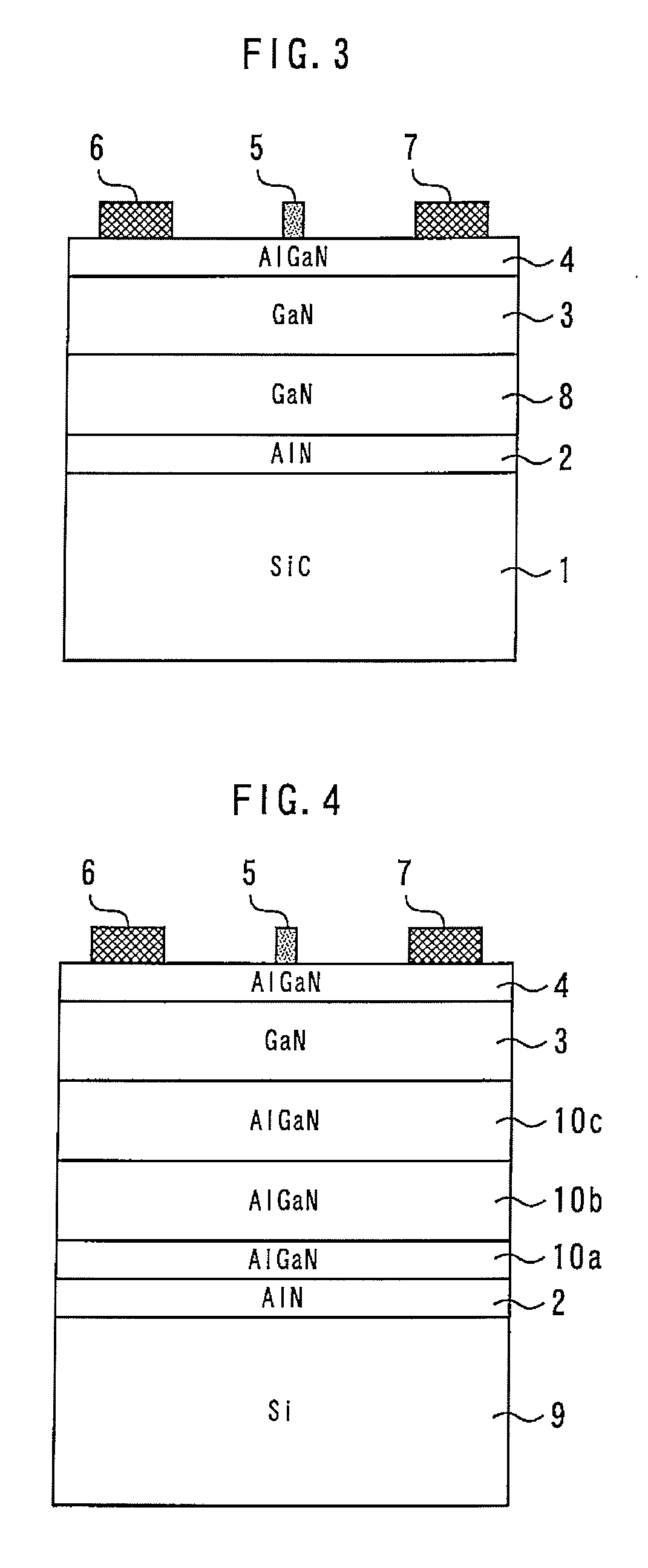Method of manufacturing nitride semiconductor device
- Summary
- Abstract
- Description
- Claims
- Application Information
AI Technical Summary
Benefits of technology
Problems solved by technology
Method used
Image
Examples
first embodiment
[0016]FIG. 1 is a cross-sectional view illustrating a nitride semiconductor device according to a first embodiment of the present invention. An AlN high-resistance buffer layer 2 having a layer thickness of 300 nm is provided on a SiC substrate 1. A GaN electron transit layer 3 having a layer thickness of 1 μm is provided on the AlN high-resistance buffer layer 2. An Al0.2Ga0.8N electron supply layer 4 having a layer thickness of 25 nm is provided on the GaN electron transit layer 3. A gate electrode 5, a source electrode 6 and a drain electrode 7 are provided on the Al0.2Ga0.8N electron supply layer 4. With carbon concentration controlled to 1018 cm−3 or above, the AlN high-resistance buffer layer 2 has a resistance value higher than the GaN electron transit layer 3 and the Al0.2Ga0.8N electron supply layer 4.
[0017]Next, a method of manufacturing a nitride semiconductor device according to the first embodiment of the present invention will be described. An MOCVD method is used as a...
second embodiment
[0021]A second embodiment uses UDMHy and NH3 as raw materials of group V when forming an AlN high-resistance buffer layer 2. The rest of the manufacturing method is the same as that of the first embodiment.
[0022]FIG. 2 is a diagram illustrating NH3 / UDMHy supply molar ratio dependency of carbon concentration. As is clear from this figure, by setting the supply molar ratio of NH3 with respect to UDMHy to 30 or less, it is possible to control the carbon concentration to 1018 cm−3 or above without changing the growth temperature or growth pressure which has influences on the crystal quality. As a result, the AlN high-resistance buffer layer 2 having desired resistivity within a range of, for example, 100 Ωcm to 1×107 Ωcm can be obtained, and therefore the structure design can be made easier. By changing the NH3 / UDMHy supply molar ratio during crystal growth, it is also possible to change the carbon concentration in the film thickness direction.
third embodiment
[0023]FIG. 3 is a cross-sectional view illustrating a nitride semiconductor device according to a third embodiment of the present invention. An AlN high-resistance buffer layer 2 having a layer thickness of 300 nm is provided on a SiC substrate 1. A GaN high-resistance buffer layer 8 having a layer thickness of 0.5 μm is provided on the AlN high-resistance buffer layer 2. A GaN electron transit layer 3 having a layer thickness of 0.5 μm is provided on the GaN high-resistance buffer layer 8. An Al0.2Ga0.8N electron supply layer 4 having a layer thickness of 25 nm is provided on the GaN electron transit layer 3. A gate electrode 5, a source electrode 6 and a drain electrode 7 are provided on the Al0.2Ga0.8N electron supply layer 4. Since the carbon concentration of the AlN high-resistance buffer layer 2 and the GaN high-resistance buffer layer 8 is controlled to 1018 cm−3 or above, these layers have higher resistance values than the GaN electron transit layer 3 and the Al0.2Ga0.8N ele...
PUM
 Login to View More
Login to View More Abstract
Description
Claims
Application Information
 Login to View More
Login to View More - R&D
- Intellectual Property
- Life Sciences
- Materials
- Tech Scout
- Unparalleled Data Quality
- Higher Quality Content
- 60% Fewer Hallucinations
Browse by: Latest US Patents, China's latest patents, Technical Efficacy Thesaurus, Application Domain, Technology Topic, Popular Technical Reports.
© 2025 PatSnap. All rights reserved.Legal|Privacy policy|Modern Slavery Act Transparency Statement|Sitemap|About US| Contact US: help@patsnap.com



